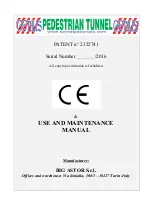
Mirus for H2 Classic GrainGage
52
H2 Classic GrainGage Calibration
4.4.2 Prepare Samples
Preparing your samples is a critical first step towards creating and maintaining an effective moisture curve.
Step 1: Plan ahead for calibration.
Creating an accurate moisture curve requires using grain samples with
a range of moisture percentages. Collecting enough samples to calibrate properly requires some advanced
planning. HarvestMaster recommends two separate strategies: planting grain varieties that will be available for
harvest before test plots are ready or harvesting border plots early and drying them to varying moistures.
Step 2: Imitate harvest conditions.
When calibrating, it is recommended that you imitate harvest conditions
as close as possible. This means grain has enough time to equilibrate to ambient outdoor temperature before
calibrating. The grain should be cycled through the hopper or cyclone to reduce grain packing differences. If
using test chamber inserts, separate moisture curves
with
and
without
inserts are required.
HarvestMaster recommends cycling samples 3–5 times each in both the benchtop sensor and the GrainGage
and then averaging the moisture readings. When possible, grain samples should be tested in the lab and in
the GrainGage within an hour of each other.
When calibrating GrainGages mounted on Quantum combines, run the combine for at least 30 minutes
before doing the moisture calibration. This ensures that the moisture sensor is at harvest temperature.
Step 3: Collect and prepare samples.
Your challenge is to create a moisture curve that is representative of the
moisture range that will be encountered during harvest. The more samples available during calibration, the
more accurate the curve will be. HarvestMaster recommends:
•
Using no less than three samples to generate a curve. The more samples the better.
•
Each sample should be at least 6 pounds.
•
At least a 3% moisture range from lowest moisture to highest moisture.
•
The more samples within about a 10% range the better, but two or three samples will suffice.
Step 4: Adjust for high moisture corn harvest.
If you have high moisture samples, HarvestMaster
recommends initially calibrating with samples below 26% to set the curve and then manually calibrating the
curve above 26% for the high moisture samples. A split curve will generate better data than an average curve.
Step 5: Annually check and tune moisture curves.
Checking and tuning moisture curves each season will
give you the best data quality.
4.4.3 Chamber Calibration Overview
It is important to maintain 75 lb (34 kg) of air pressure during the chamber calibration. If needed, run the
combine to maintain the air pressure.
Calibrating the chamber to create a moisture curve consists of two parts:
1. Calibrating with moisture and test weight.
2. Calibrating with only moisture.
Both of these parts are necessary to create an accurate moisture curve.
To begin the calibration you will need one sample that is at least 6 lb (2.7 kg) at the industry moisture
standard (e.g., the industry moisture standard for corn is 15.5%). Cycle this sample three times after
providing the Known Moisture and Test Weight. These values do not change between cycles of the same
sample.
Содержание HarvestMaster mirus H2
Страница 1: ......
Страница 7: ...CHAP TER ONE Mirus Ins tallation...
Страница 11: ...Mirus and GrainGage S etup CHAP TER T WO...
Страница 32: ...H2 Clas sic GrainGage Diagnos tic s and Aler t s CHAP TER THREE...
Страница 42: ...GrainGage Calibration CHAP TER FOUR...
Страница 71: ...Field Maps CHAP TER FIVE...
Страница 98: ...Har ves t Mode CHAP TER SIX...
Страница 111: ...Mirus for H2 Classic GrainGage 111 Harvest Mode 6 3 7 List View In List View you can see the data in the form of a chart...
Страница 120: ...Standard Grain Information APPENDIX A...
Страница 123: ...Troubleshooting APPENDIX B...
Страница 129: ...Limited Warrant y APPENDIX C...
















































